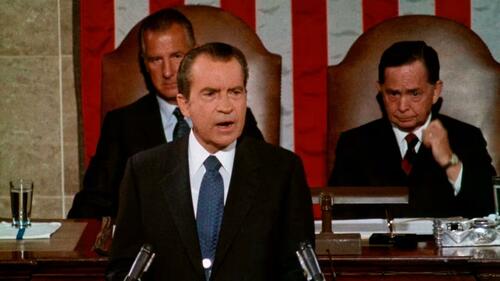
«Шок Никсона» может помочь нам понять Трампа
Об этом сообщает Huw van Steenis со ссылкой на Financial Times.
Автор является вице-председателем в Oliver Wyman и бывшим глобальным главой банков и диверсифицированных финансовых исследований в Morgan Stanley.
Каковы будут долгосрочные финансовые последствия тарифов Трампа? Мы можем быть в 90-дневной паузе, но вопрос остается актуальным. Оглядываясь на опыт Ричарда Никсона в 1971 году, можно понять, что может произойти дальше.
 Президент Ричард Никсон обращается к Конгрессу, чтобы объяснить свою новую экономическую политику в 1971 году.
Президент Ричард Никсон обращается к Конгрессу, чтобы объяснить свою новую экономическую политику в 1971 году.Конечно, недавние события имеют некоторые общие черты с «шоком Никсона», который произошел, когда тогдашний президент снял доллар с золотого стандарта, ввел 10-процентный импортный тариф и ввел временный контроль над ценами.. Такое ослабление режима привело к периоду глобальной экономической нестабильности и неопределенности. Это не только привело к потере деловой уверенности, но и привело к стагфляции. Цена и заработная плата Никсона оказали эффектное негативное влияние, вызвав нехватку продуктов и помогая стимулировать рост цен на заработную плату. Весь эпизод был ключевым фактором огромной инфляции 70-х годов.
Как и в случае с тарифами Трампа, тарифы Никсона были введены для того, чтобы заставить страны изменить условия торговли, чтобы помочь сократить торговый дефицит США. Его самые большие опасения были Япония и Германия. "Моя философия, господин президент, заключается в том, что все иностранцы хотят облажаться с нами, и наша работа заключается в том, чтобы сначала облажаться с ними." Об этом сообщил министр финансов Джон Конналли.
В сегодняшнем гиперфинансовом мире мы уже видели, что рынки облигаций могут заставить политиков гораздо быстрее. В 1971 году прошло четыре месяца, прежде чем тарифы Никсона были отменены по Смитсоновскому соглашению. Но шок уже сделал достаточно, чтобы катализировать чрезвычайные изменения в финансах, что привело к созданию новых инструментов для ставок на направление процентных ставок и хеджирования валютного риска, включая фьючерсы и опционы на валютном рынке.
Боль от стагфляции в банковской системе вызвала огромные изменения в финансовом поведении и финансовом регулировании.. Инвесторы перевели распределение активов на золото и реальные активы для сохранения стоимости.. Между тем Корпорации и вкладчики все чаще переводят свою деятельность из банков на рынки облигаций. С тех пор доля банковского кредитования в общем объеме заимствований в экономике падает. Короче говоря, современные финансы были созданы в начале 1970-х годов.
Есть параллели и для стран за пределами США, которые в настоящее время обеспокоены тарифами. Еще в 1971 году было плохое отношение к ближайшим союзникам США. Никсон ударил по Канаде тарифами, несмотря на то, что ее валюта уже плавает. Как премьер-министр Сегодня канадцы не отступили, и в конечном итоге тарифы были сняты. Могло быть и хуже: Конналли также хотел, чтобы США вышли из давнего пакта с Канадой об автомобилях и автозапчастях. Но Пол Волкер исправил это, согласно его мемуарам, дерзко поощряя чиновника Госдепартамента срывать последнюю страницу каждого пресс-релиза, в котором говорилось об этом.
В конечном счете, необходимость стабилизации международных отношений с союзниками помогла отклонить баланс от тарифов. Генри Киссинджер, тогдашний советник по национальной безопасности, «обеспокоился тревожным воздействием продолжительной конфронтации на союзнические отношения».
Никсон также оказал огромное давление на ФРС в связи с экспансионистской денежно-кредитной политикой, чтобы компенсировать шок. Уильям Сафайр, спичрайтер Никсона, рассказывает, как Администрация поддерживала постоянный поток анонимных утечек, чтобы оказать давление на председателя ФРС Артура Бернса.Включая плавающее одно предложение о расширении размера Федеральной резервной системы, чтобы Никсон мог упаковать комитет с поддержкой новых членов.
В конце концов, четырехмесячный налог Никсона, возможно, способствовал переоценке доллара, но он не достиг желаемых целей и не оказал заметного влияния на импорт. Экономические шоковые волны этого шага, однако, рванули через десятилетия. Даже создание евро связано с этим. Цифровой евро или более глубокие европейские рынки капитала будут следующими? Пока неясно, но история предполагает, что последствия этого последнего шока будут ощущаться в течение многих лет.
Тайлер Дерден
Солнце, 04/13/2025 - 20:50













![MOPS: utrata zasiłku przez rentę wdowią [Przykład]](https://g.infor.pl/p/_files/38388000/podwyzki-38388417.jpg)




